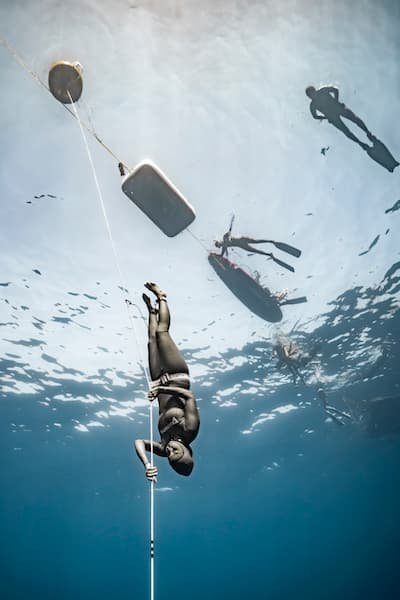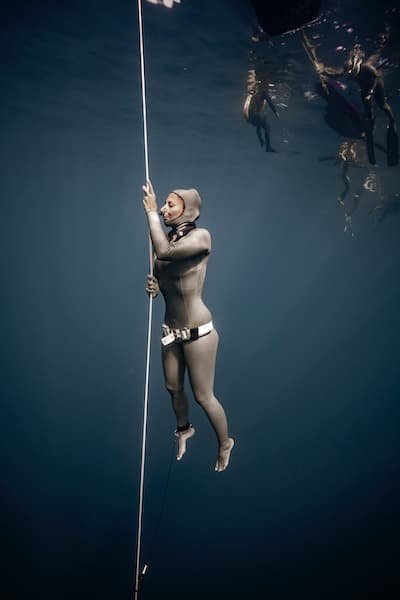Embarking on the exhilarating journey of deep freediving demands more than just an adventurous spirit; it requires a foundation built on education, continuous training, dedication, and unwavering perseverance. In this blog post, we will share three essential tips that can elevate your deep freediving experience.
One essential suggestion I want to share is the practice of visualizing your dives. This proves to be a crucial technique in fostering a smooth diving experience, aiding in mental preparation and prompting our bodies to function almost automatically during deep dives. The significance lies in ensuring that crucial steps, such as taking a mouthfill or initiating freefall, are not overlooked. By incorporating visualization, one can reduce dependence on alarms, which are prone to being unheard and can disrupt dives. Whether through visualization, counting, or tracking the number of kicks before certain actions, this approach aids in maintaining a disciplined routine.
The key to effective visualization is to approach it positively. This not only contributes to relaxation but also mentally prepares you for an enjoyable dive. It's crucial to include the surface and protocol aspects in your visualization, as this mechanically ingrains the entire process, helping you remember important steps like recovery breaths. This meticulous approach could prove instrumental in preventing disqualifications, avoiding blackouts, or recovering smoothly from issues like a Loss of Motor Control (LMC). Visualization stands as a highly recommended tool for all deep divers and, indeed, divers worldwide. Employing it positively, envisioning your dives as delightful experiences, ensures that safety protocols are not forgotten amidst the excitement of the dive.

As previously mentioned, when engaging in deep dives beyond 60 meters, or following AIDA's recommendation of 55 meters, it's crucial to adhere to another safety guideline: limit yourself to only one deep dive per session. While warming up is permissible, diving deeper than 60 meters should prompt you to conclude your diving activities for that session. Ideally, it would be advisable to abstain from safety dives as well, but if you're diving with a buddy, and safety measures are necessary, ensure a significant time gap between your deep dive and providing safety assistance.
The recommended waiting time after a 60-meter dive is at least 12 minutes, calculated by dividing the depth by 5. However, it is prudent to extend this interval, allowing your body ample time for complete recovery. Even if you feel fully recovered, waiting is essential to account for not just fatigue but also the presence of excess nitrogen. Neglecting this precautionary period can lead to decompression symptoms, as I experienced when, unaware of these rules, I performed three consecutive 60-meter deep dives in one session. Despite feeling fine initially, excess nitrogen accumulation can become problematic. Therefore, it is strongly advised not to exceed the depth of 60 or 55 meters more than once in a single diving session. Once adequately rested, you can engage in safety dives for your buddy, but exercise caution to avoid overexertion.

Here's another crucial tip, especially for deep dives when the inclination to push beyond limits may arise. Finding the balance between overcoming fear and maintaining bodily awareness can be challenging. While the desire to surpass one's limits is natural, it's imperative to recognize signals that suggest it might not be the best course to continue descending. My recommendation is to always listen to your body and not hesitate or feel guilty about making an early turn. Turning early is a wise decision if things aren't going well or if you're not feeling sufficiently relaxed.
Choosing to turn early can prevent potential injuries such as lung or throat injuries and avoid squeezes, which could result in considerable downtime out of the water. It's a prudent move to assess the dive after each 10-meter increment, asking yourself questions like "How do I feel at this point? Am I diving deeper out of fear or necessity?" Evaluate the present moment. If you feel good, there might be no reason to turn. However, if you sense discomfort or unease, it is entirely acceptable to turn and try again in the next diving session.